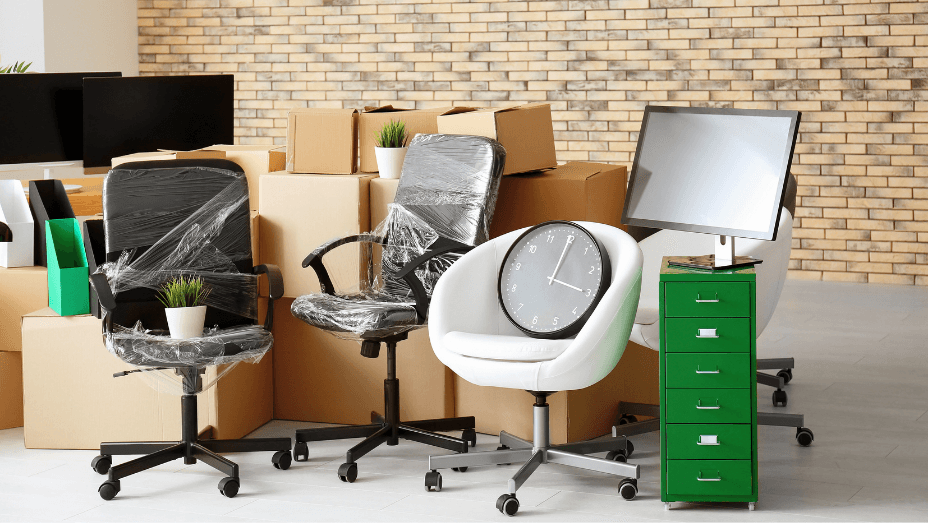Moving houses and offices is extremely difficult. In fact, studies show that more than 45% of people think moving is more stressful than divorce or having kids.
Add this to the idea that you have to move offices and that the success of an entire business depends on how organized and clear you are about everything, and things can very easily get... mighty stressful.
How to handle office moves if you're an HR professional or Facility Manager?
Read on and find out more.
TL;DR:
- Office moves can be stressful and require good planning to be successful.
- Some key elements to consider when preparing for an office move include getting leadership and team buy-in, making sure all documents are in order, determining your company’s moving budget, creating a timeline for the move, involving all relevant stakeholders, and creating a communication plan for before, during, and after the move.
- An office relocation checklist is a great tool to make sure nothing important is forgotten during the move.
- A step-by-step office move checklist could include reviewing the current lease, creating a committee, assessing the needs and creating a blueprint for the new office, establishing the budget and timeline, and getting moving coverage if needed.
Office Move Checklist: What Is It, Exactly?
An office move checklist is a structured and detailed document designed to guide businesses through relocating their workspace. It outlines a series of tasks and steps necessary for a successful move, from planning and preparation to execution and post-move activities. This comprehensive tool helps businesses stay organized, prioritize tasks, allocate resources, and smoothly transition to a new office space. By providing a clear roadmap, the office move checklist minimizes disruptions, manages risks, and aids in maintaining productivity during the relocation process.
How Do You Prepare for an Office Move?
Successful office moves start with good planning. Because office moves involve so many...moving parts, it's essential for you to draw a clear, A-to-Z plan of what will happen over the weeks preceding the actual move.
Some of the things you should definitely keep in mind at this stage include:
Getting Leadership and Team Buy-in
The entire team needs to be on board with the move and all the details it entails. Moving offices can be slightly disruptive to business, so getting everyone to sign off on the idea is very important.
You should also explain the reasons behind the move and what sort of benefits it will bring so that employees understand why this is happening and can get excited about the new possibilities.
Making Sure All Moving-Related Documents Are in Order
There are a lot of documents that need to be taken care of before you can even think about physically moving anything.
You'll need to cancel or transfer leases and insurance policies, inform utility companies, update your business's address with the government, and more.
To make sure you don't forget anything important, it's a good idea to create a checklist of all the documents you need to take care of.
Determining Your Company’s Moving Budget
Another crucial aspect of preparing for an office move is figuring out how much money you have to work with.
Remember that you'll need to account for the cost of renting a moving truck or hiring a professional moving company, as well as any necessary renovations or repairs that need to be made to the new office space.
Putting Together a Timeline for the Move
Once you have a budget in place, you can start putting together a timeline for the actual move.
Keep in mind that office moves usually take weeks or even months to complete, so it's important to give yourself plenty of time to get everything done.
In general, you should start planning the move at least three months in advance.
Involving All Relevant Stakeholders in the Planning Process
Regardless of whether you're in the HR department or a Facility Manager, chances are you won't be all alone in this. Make sure you involve all the relevant stakeholders in the planning process, from the get-go. This way, everyone will be on the same page and there will be fewer surprises down the road.
Creating a Communication Plan For Before, During, and After the Move
Moving offices can be disruptive to business, so it's important to have a clear communication plan in place before, during, and after the move.
This office moving plan should include information such as when the move will take place, who will be responsible for what, and how employees can stay up-to-date on the latest developments.

Why Should You Have an Office Relocation Checklist?
Of course, moving to a new office can be quite exciting, but office relocation can also get very chaotic, very easily. Even if you're the most organized person in the world, there are just too many things that need to be taken care of, and it's very easy to forget something important. Here are some benefits of an office move checklist:
- Organization: Keeps all tasks and details in one place for easy reference and tracking.
- Efficiency: Streamlines the moving process by breaking it down into manageable steps.
- Time management: Helps allocate time effectively to tasks, ensuring a smooth transition.
- Task delegation: Clearly defines responsibilities among team members for each task.
- Budget control: Helps monitor expenses and avoid overspending during the move.
- Coordination: Facilitates communication and coordination among different teams involved.
- Risk mitigation: Identifies potential challenges and allows for proactive problem-solving.
- Prioritization: Enables prioritizing critical tasks to minimize disruptions to operations.
- Logistics planning: Assists in arranging transportation, utilities setup, and other logistics.
- Documentation: Keeps records of agreements, contracts, and important contacts.
- Stakeholder communication: Keeps stakeholders informed about the move's progress.
- Minimized downtime: Reduces downtime by efficient planning and execution.
- Employee support: Provides guidelines to help employees navigate the move seamlessly.
- Post-Move evaluation: Allows for post-move assessment to improve future relocation processes.
Our Step-By-Step Office Move Checklist
Phase I: 6 Months Before the Office Move
Believe it or not, the best way to move offices is by planning way ahead of time. Yes, the moving itself will only take weeks or up to a month, but planning should start at least six months before the office move.
Review the Current Lease
This is an important first step, as you need to know how much time you have left on your lease. If you're moving because your current lease is about to expire, then you'll have a bit more flexibility when you move.
However, if you still have a year or more left on your lease, you'll need to give your landlord at least six months' notice before you move out. Do check with your lease and see how much of an advance notice you need to give your landlord.
Create a Committee
Creating a "moving committee" is essential because there are just too many things that need to be taken care of for one person to handle.
The moving committee should include representatives from all the departments, so you can make sure everything and everyone's needs have been covered during the planning phase and that the new space will help you create an amazing workplace experience for your team.
Assessing the Needs & Creating the Blueprint for the New Office
The next step is to assess the needs of your company and employees and create a blueprint for the new office space. See how much space you need, assess how many desks will fit into the new space (particularly if it's smaller), and decide on the layout of the new office.
You should also take this opportunity to reassess your current furniture and decide what needs to be replaced and what can be reused.
Establish the Budget and the Timeline
After you've assessed your needs and created a blueprint for the new office, it's time to establish the budget for the move.
You should also create a timeline for the move, which will include key milestones such as when you need to give notice to your current landlord, when you need to start packing, and when the actual moving day will be.
Get Moving Coverage (If Needed)
This may not always be necessary, but if you want to ensure your furniture or equipment for the move, this would be the time to do it.
Find a New Place
Of course, you'll need to find a new office space that meets your needs and budget.
Research different neighborhoods and areas, and visit a few office spaces before making your final decision. Keep in mind your team's needs, as well as whether or not you have adopted a hybrid work model yet (which can influence how large or small your new office space needs to be.)

Phase II: 3-2 Months Before the Office Move
At this point, the office move is getting closer by the minute, so this phase is the perfect one to make the office relocation more public, plan the logistics, and think of all the important elements of the moving process.
Notify Employees
At this point, you should start to notify employees of the upcoming office move. This way, they'll have time to start packing their personal belongings and getting ready for the move, as well as plan ahead on how they will travel to the office.
You should also provide employees with the timeline for the move, as well as key information such as the address of the new office, and the contact information for the moving company.
Communicate the News Externally
It may not be the time to issue a press release (yet!), but communicating the news to partners, big clients, and important external stakeholders is essential at this point. Doing it now will show transparency on your end and it will help you avoid any last-minute surprises.
Audit Current Office & Plan Ahead
This is the time to go through your current office and get rid of anything you don't need. This includes old furniture, equipment, and storage units.
You should also make sure that you have an accurate inventory of all your furniture and equipment, as this will come in handy throughout the entire moving process.
Last, but definitely not least, plan ahead for all the things you will need at the new office (and which you don't have or might need replacements.)
Pull the Logistics Into Place
Now is also the perfect time to start working on all the logistics for the move, such as hiring a moving company, ordering packing supplies, and booking a storage unit (if needed.)
If you're handling the move internally, now is also the time to start assigning roles and responsibilities to members of your team.
Lock in the New Office & Moving Date
This is the time to sign the lease for your new office space and officially lock in the date of the move.
Phase III: 1 Month Before The Office Move
If you feel like the clock is ticking on your office relocation project, it's because...it actually is. At this phase, you should have all the details of what needs to be done in place, so you can start taking actual action.
Run an Inventory of All the Office Objects
A month before the move is the time to do another inventory check of all your office objects, furniture, and equipment. This will help you make sure that nothing has been damaged or lost, and it will give you a chance to get rid of anything else you don't need.
Start Buying Moving Supplies
If you haven't already, now is the time to start buying all the necessary moving supplies, such as packing boxes, tape, labels, and bubble wrap.
You should also start packing up any items that you know you won't need in the office until after the move, such as seasonal decorations or extra office supplies.
Transfer All Utilities, Leases, and Insurance Policies
This is also the time to start transferring all your utilities, leases, and insurance policies to the new office space. Doing it now will help you avoid any disruptions or surprises come moving day.
Make Sure the Tech Will Be Installed on Time
If you're depending on outside help to get your new office's tech infrastructure up and running, make sure that everything is on track and will be installed on time. This includes your internet, phone lines, and any other tech equipment you might need.

Phase IV: 2-3 Weeks Before the Office Move
At this stage, all of the moving details should be in place and you should mostly be handling double-checks, Plan B's, and making confirmations both with the internal moving committee and with all the external services you've hired for this project
Update Company Address Listings
Make sure that your company's address is updated on all of your listings, such as Google My Business, Yelp, and any other relevant directories. Alternatively, you can leave this for after the move as well, particularly if you get a lot of people walking into your physical office for your goods or services.
Order New Office Keys and Cards
If you're using keycards or fobs to access your office space, make sure that you order new ones for all your employees. You should also update the alarm code for the office if you have one.
Confirm Tech Installations & Moving Company
At this point, you should have already confirmed the date and time of installation for your new office's tech infrastructure. You should also reconfirm all the details with your moving company, so everyone is on the same page come moving day.
Back-up Documents & Data
You should back up all your company's important documents and data, just in case something gets lost or damaged during the move.
Re-Check the Plan With the Team
This is also a good time to do a final check-in with your internal moving committee to make sure that everyone is still on track and knows what they need to do.
Phase V: 1 Week Before the Office Move
The office relocation day is almost here! At this phase, everything should be in place at the new office, so you can just grab your office inventory and move it there, ready to start work as soon as possible.
Survey the New Space
Take a walk-through of the new office space with the moving company, so you can identify any potential problems and make sure that everything is ready for the move.
Review the “Day-Of” Schedule
This is also a good time to review the "Day-Of" schedule with your internal moving committee and make sure that everyone knows when they need to do it (and how.)
Get Packing Materials and Protection
If you haven't already, now is the time to start packing up your office inventory. Make sure you have all the necessary packing materials and protection, such as packing boxes, tape, labels, and bubble wrap.
Get All the Parking Passes, Access Cards, and Keys
If you're using parking passes, access cards, or keys to get into the new office space, make sure that you have them all ready and distributed to the relevant people.
Designate Team Members to Help With Packing and Unpacking
If you haven't already, designate a team of people who will be responsible for packing up and unpacking the office inventory. This way, you can be sure that everything will be done properly and nothing will get lost or forgotten.
Phase VI: On the Relocation Day
Finally, the big day is here! There's a lot of buzzing around and stress in the air, but with a clear mind and a good plan, you'll make it through (and be proud of what you achieved!) Here are some of the things you should keep in mind for this phase:
Turn on the Lights & Heat at the New Office
If you haven't already, make sure that the lights and heat/ A/C are turned on at the new office space. This will make it more comfortable for everyone working with you on the office move project. After all, nobody wants to work in the dark (or in the cold), right?
Plug in All the Tech & Test It
If you've already installed the new office's tech infrastructure, make sure that everything is plugged in and working properly. This includes the computer network, phones, and any other equipment that you'll need to be up and running on day one.
Run a Detailed Check of the New Office & Report Any Damage
Once all the furniture and equipment have been moved into the new office, do a final check to make sure that everything is in its proper place.
Arrange the Office Furniture & Supplies According to the Blueprint
If you have a blueprint of the new office layout, use it to arrange the furniture and supplies in their proper place. If not, now is the time to get creative and figure out the best way to use the space you have.
Assess the State of the Old Office & Confirm the End of the Lease
Once you're sure that everything has been moved out of the old office, take a walk-through to assess the state of the space. If everything is in good condition, you can confirm with the landlord that your lease is officially ended and hand in the keys.

Phase VII: After the Office Relocation
OK, the hardest part is over now, but there are still some things you need to take care of. Some of the essential ones include:
Communicate Internally
Make sure that all your employees are aware of the office move and have all the information they need, such as the new address, directions, and all the details they need to come to work.
Make Sure All Company Address Listings Have Been Updated
Check that your company's address has been updated on all official listings, such as the website, business cards, letterhead, and email signatures across the entire organization.
Hand Out the Keys & the Cards
Once you're sure that everyone knows about the office move and has all the information they need, it's time to hand out the keys and access cards.
Issue a Press Release & Social Media Announcement
If you want to let the world know about your new office, issue a press release and post about it on social media. This is also a great way to show off your new space and give people a sneak peek of what's to come (which may be great material both for your marketing team and for your HR/ employer branding team.)
Extra Tips for Organizations Moving to Smaller Offices
If you have embraced a hybrid work model, chances are that you might have to move into a smaller office now. While the experience might feel a bit saddening (particularly if you were used to a larger office), learn that you can use this opportunity to create an office space that's cozier, more productive, and even more enjoyable than the previous one.
There are a lot of smart ways to design smaller spaces and make them look really good. From decor objects to designating various types of areas around the office (relaxation area, standing desks, focus booths, etc.), there are many ways you can make a small space feel just right.
Here are some things you might want to keep in mind if you're moving into a smaller office:
Get Rid of Office Inventory You Don’t Use
If you have a lot of old inventory taking up space in the office, now is the time to get rid of it. This includes everything from outdated equipment to old marketing materials.
Donate what you don't need, sell what can be used (your employees might actually take an interest in this), and recycle the rest.
Be Extra Careful With the New Office Blueprint
Take extra time to plan the new office layout, as even a few inches can make a big difference. Use a blueprint software or seek professional help to get this done right from the get-go.
Invest in Software to Help You Manage the New Space
Space and office booking software can make your life (and the life of your employees) a lot easier. It can help everyone book the office space or even the desk they need on a specific day, so they can avoid having to search for a place to sit every morning.
Furthermore, such software can help the business as well, as it will provide you with a surefire way to manage your space efficiently. Moreover, good software (such as the one we have at YAROOMS, for example) will also provide you with a treasure trove of data on how your space is being used, so you can further optimize it for maximum productivity.
Essential Supplies for an Office Move
Embarking on an office move can feel like navigating through a dizzying maze. Fortunately, having the necessary items from the get-go will take you several steps closer to a successful relocation. Compiling these essentials in your office move checklist will simplify the whole process tremendously while minimizing downtime during the transition phase.
Boxes/Containers
Successful office moves begin with proper packing & organizing. Therefore, boxes and containers should hold the top slot in your moving checklist for the office.
Depending upon the nature and size of your office equipment, varying container sizes may be required. Regular cardboard boxes work great for smaller items like stationary and files, while plastic bins are perfect for heavier objects or fragile electronics.
Moreover, add special-purpose containers such as file boxes and computer crates into your relocation of office checklist; they'll come in handy when dealing with sensitive materials.
Packing Materials
Investing in the right packing supplies is akin to securing insurance for your valuable assets during transit. Besides sturdy containers, other crucial elements include quality packing materials, such as bubble wrap.
It protects against jolts or drops - especially when handling delicate or high-value items such as electronic devices or pieces of artwork. Make sure you use packing materials liberally when boxing up any fragile articles to limit potential damage during transport.
Labels, Markers, and Tape
Many overlook this aspect while preparing for office relocation without realizing how much time labels save while unpacking and arranging at the new location.
Not labeling boxes clearly can lead to chaos at the destination, where employees need help finding what they need among stacks of unmarked containers. Therefore, stock up on durable markers and post-it notes before moving.
We also suggest a labeling system where each department or employee has a set of colors for easy identification. And don’t forget – you’ll need plenty of packing tape to seal those boxes securely!
Furniture Dolly, Hand Truck, or Lift Gate
One vital part of moving heavier items like furniture and large appliances is mechanical aids like dollies, hand trucks, or lift gates. Utilizing these tools protects your equipment against potential damage and reduces the risk of personal injury.
Specifically, use a dolly or hand truck when shifting heavy filing cabinets or aisle shelving units. Add "acquire a lift gate vehicle" to your office move checklist for bulky office machinery such as copiers, printers, and server racks.
Utility Carts
Utility carts may seem an unexpected addition to the office move checklist; however, they play a pivotal role during the relocation period. Providing employees with utility carts allows them to shift their immediate desk contents – notebooks, folders, devices – hassle-free.
This encourages individuals to take responsibility for their work equipment and consolidates the smaller items into one conveniently mobile place: a huge time-saver that will benefit already stressed-out team members during this transitory stage.

Office Move Checklist FAQ
Navigating the maze of office relocation can be daunting, but with an effective plan and a solid checklist at your disposal - it doesn't have to be. The following frequently asked questions aim to demystify essential elements of moving offices.
What Do You Need for an Office Move?
Carrying out successful office relocations involves many crucial elements. Here's what you'll typically need:
- An Office Move Checklist: this comprehensive list ensures every stone is turned on during the move.
- Planning Committee: assembling a team responsible for managing different aspects of your move.
- Reliable Movers: hiring professionals familiar with commercial moves reduces risk and boosts efficiency.
- Packing Supplies: these include boxes, packing tape, markers for labeling, protective materials like bubble wrap, and so on.
- Updated Contact Information: ensure you've informed all stakeholders of your new address.
By ensuring these constituents are in place, you're well-positioned for a smooth transition towards office relocation.
How Do You Manage an Office Move?
Managing an efficient office redistribution starts by creating a comprehensive relocation office checklist that includes every detail needing attention. This checklist generally encompasses decluttering before packing, arranging professional movers, or setting up systems at a new location.
Furthermore, defining clear roles among staff members and assigning various responsibilities will distribute workload fairly and boost accountability within the team.
Lastly, maintaining open lines of communication is paramount to managing timely updates and handling any unforeseen challenges promptly. Use modern collaboration tools to enhance team coordination.
How Do You Plan a Successful Office Move?
Fundamental planning steps towards a successful move usually encompass:
- Drafting an initial plan far ahead
- Creating a detailed budget
- Hiring reliable moving services
- Coordinating with IT for seamless tech transfer
- Running necessary training sessions
Also vital is ensuring that you update all stakeholders, clients, suppliers, and the postal service about your new operating location.
What Do I Need to Ask My Team Before Moving Office?
A bottoms-up approach with all staff input can make the transition smoother. Things you might want to discuss include:
- What resources will they require on the first-day post-move?
- Are any critical files or documents needed immediately after settling down?
- Preferred setup for their new workspace, like equipment or layout?
- Do any upcoming work commitments affect their availability during the move period?
Active solicitation of staff feedback can aid in tailoring your office move checklist addressing everyone's needs, resulting in fewer hiccups along the way!
Remember that relocating an office doesn't only mean moving physical items but also means transferring your company's spirit and culture. Patience, flexibility, and engaging open dialogue will underpin success in this endeavor. So, start crafting that bespoke moving checklist for the office and confidently embark on this exciting journey!












